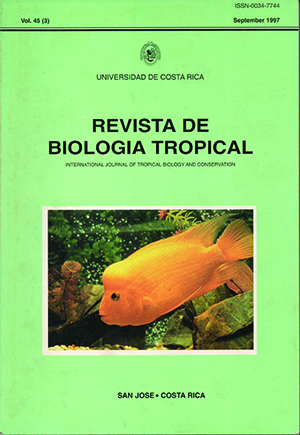Resumen
Se realizaron muestreos mensuales de las descargas comerciales de Mugil cephalus y Mugil curema en la laguna de Tamiahua, Veracruz. Se revisaron un total de 160 individuos de abril de 1991 a marzo de 1992. El sedimento y grupos taxonómicos presentes en el contenido estomacal fueron extraídos de la porción cardíaca del estómago. Las muestras izb sedimento se analizaron por el método de "frotis" en lámina delgada (Rothwell 1989), el tamaño y composición de sedimento se cuantificaron por el método de conteo de grano.Citas
Abarca-Arenas, L. G. & E. Valero-Pacheco. 1991. First approach for a trophic model for Tamiahua, coastal lagoon in Mexico, p. 1-16. In V. Christensen and D. Pauly (eds) Trophic models of Aquatic ecosystems. ICLARM Conference Proceedings No. 26.
Carver, R. E. 1971. Procedures in Sedimentary Petrology. Wiley-Interscience, Nueva York. 453 p.
Darley, W. M. 1987. Biología de las algas: enfoque fisiológico. Limusa, México, D. F. 236 p.
Folk, R. L & c. Ward. 1957. Brazos bar, a study in the significance of grain size parameters. J. Sedim. Petrol. 27:3-27.
Folk, R. L. 1974. Petrology of Sedimentary Rocks. Hemphill's, Austin, Texas 159 p.
Hickling, C. F. 1970. A contribution to the natural history of the English grey mullet (Pisces, Mugilidae). J. Mar. Biol. Ass. U. F. G. . B 50:609-633.
Marais, J. F. K. 1980. Aspect of food intake, food selection and alimentary canal morphology of Mugil cephalus (Linnaeus, 1758), Liza tricuspidens (Smith, 1935), L dumerili (Steindachner, 1869). J. Exp. Mar. Biol. Ecol. 44:193-209.
Marianni, A, S., Panella, G. Monaco, & S. Cataudella. 1987. Size analysis of organic particles in the alimentary tracts of Mediterranean mullet species suitable for aquaculture. Aquaculture. 62:123-129.
Márquez-García, A. Z. 1995. Sedimentología y Geomorfología de las lagunas de Pueblo Viejo, Tamiahua y Tampamachoco, Veracruz. Informe Técnico Final, Proyecto Divisional, Depto de Hidrobiología, Univ. Autón. Metropolitana- Iztapalapa, México. 24 p.
Méndez U. M. N., V. W. Solís & A. E. Carranza. 1986. La importancia de la granulometría en la distribución de organismos bentónicos. Estudio de playas del Estado de Veracruz. México. Ann. Inst. Cienc. del Mar y Limnol. Univ. Autón. México. 13(3):45-56.
Odum, W. E. 1970. Utilization of the direct grazing and plant detritus food chains by the striped mullet Mugil cephalus, p. 222-240. In J. H. Steele (ed). Marine food chains. Oliver and Boyd, Edinburgo.
Osorio, D. D. 1988. Ecología Irófica de Mugil Curema, M incilis y M. liza (Pisces: Mugilidae) en la Ciénega Grande de Santa Martha Caribe Colombiano. I. Análisis cualitativo y cuantitativo. An. Inst. Inv. Mar. Punta Betin. 18:113-126.
Rothwell, A. G. 1989. Mineral and mineraloids in marine sediments. Elsevier, Nueva York. 278 p.
Sánchez, R. M. P. 1995. Análisis de los hábitos alimenticios de Mugil cephalus (Linnaeus, 1758) y Mugil curema (Valenciennes. 1836) con base en la presencia de diatomeas. Tesis de Maestría. Universidad Nacional Autónoma de México, México.
##plugins.facebook.comentarios##

Esta obra está bajo una licencia internacional Creative Commons Atribución 4.0.
Derechos de autor 1997 Revista de Biología Tropical


